Durability Properties of Lightweight Foamed Concrete Reinforced with Lignocellulosic Fibers
Abstract
1. Introduction
2. Materials and Methods
3. Mix Design and Sample Preparation
4. Test Methods
4.1. Slump Test
4.2. Ultrasonic Pulse Velocity (UPV) Test
4.3. Porosity Test
- Ws,a = weight of saturated sample in air
- Wdry = weight of oven-dried sample
- Ws,w = weight of saturated sample in water.
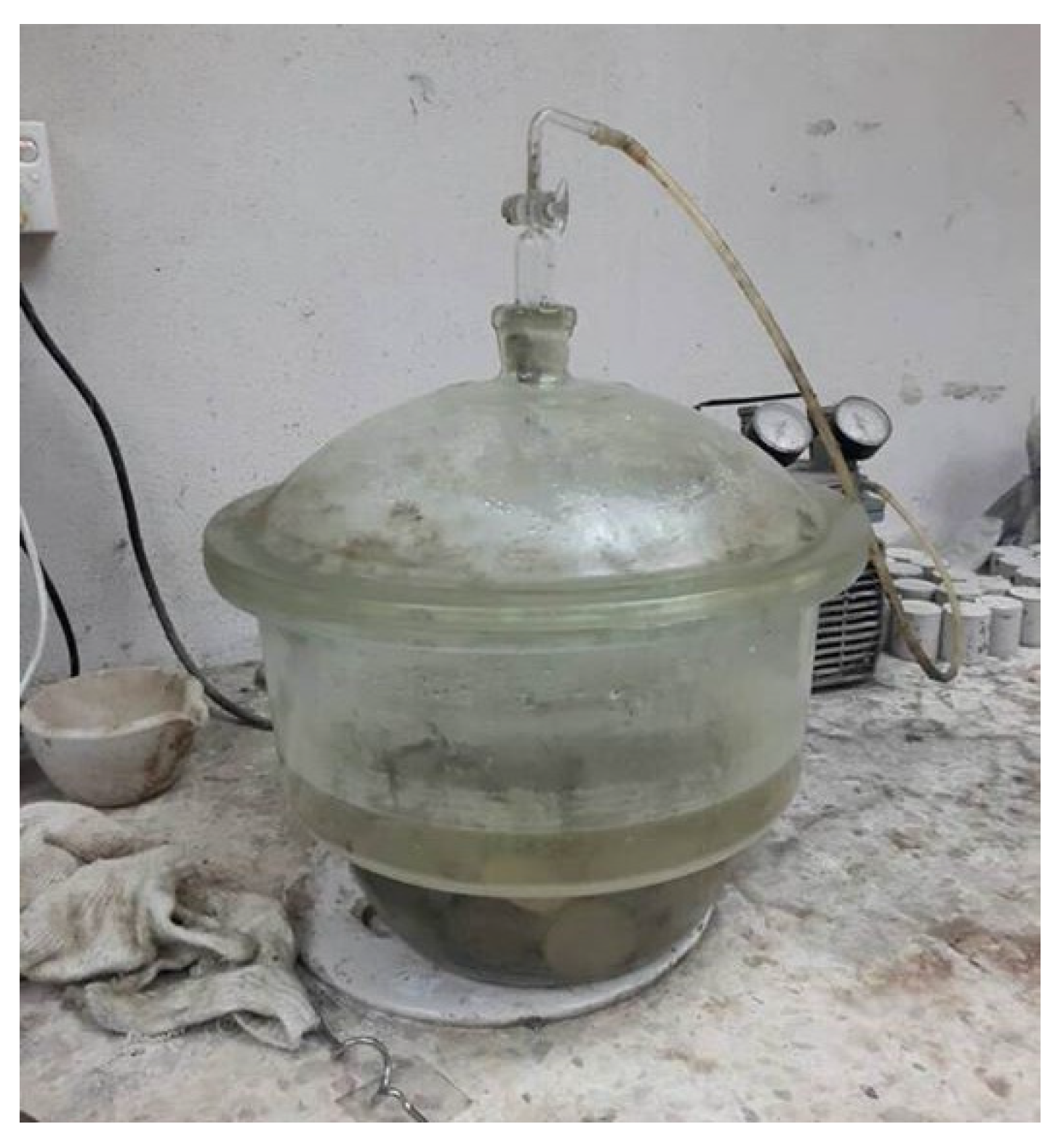
4.4. Water Absorption Test
- Ws = Saturated surface dry weight
- Wd = Oven-dried weight.
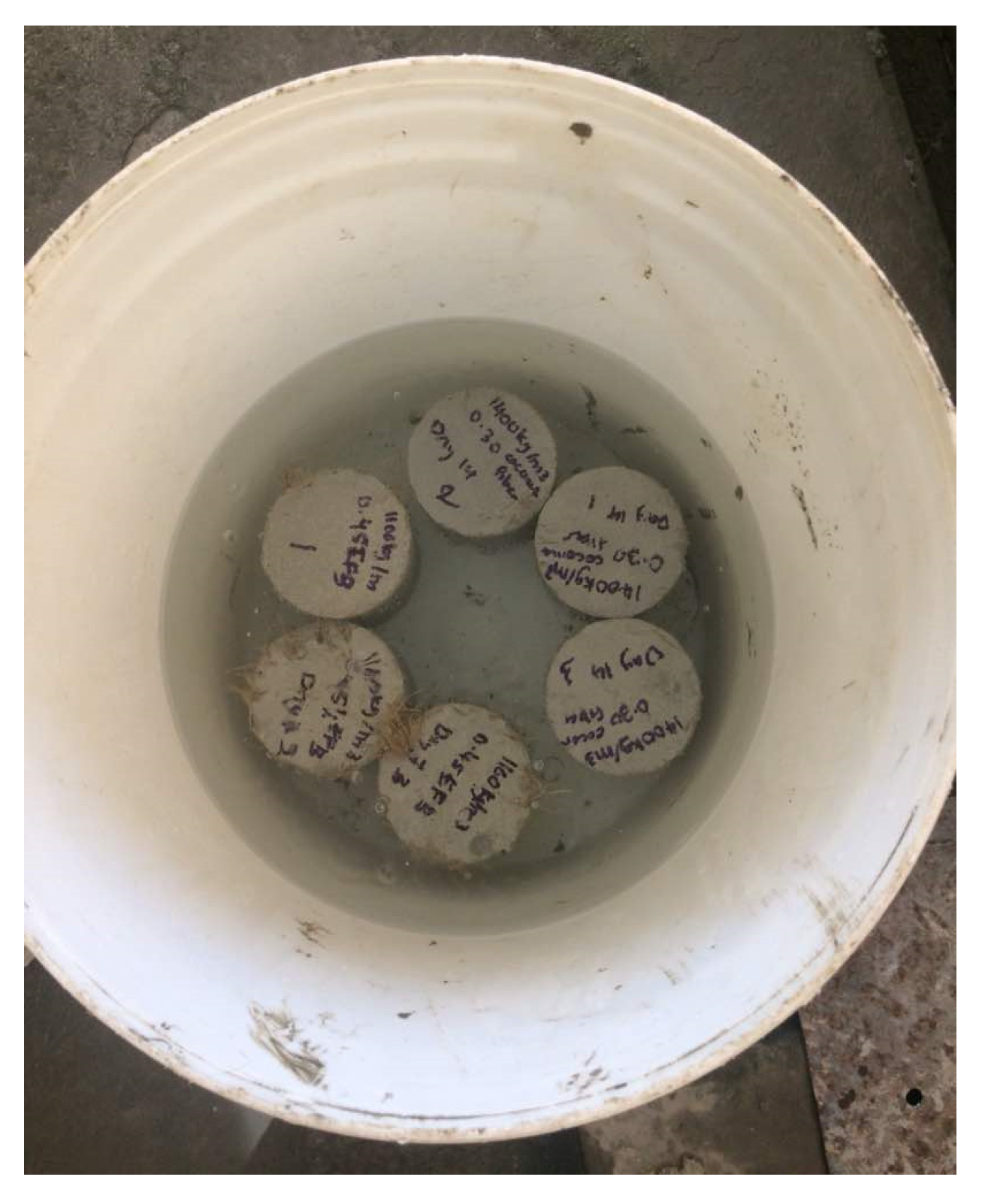
5. Results and Discussion
5.1. Workability
5.2. Ultrasonic Pulse Velocity
5.3. Water Absorption
5.4. Porosity
5.5. Porosity-Water Absorption Relationship
5.6. Porosity-Ultrasonic Pulse Velocity Relationship
6. Conclusions
- Addition of jute fiber led to optimal workability (slump) which recorded a slump of 238 mm and 230 mm for 700 kg/m3 and 1400 kg/m3 densities, respectively. Concurrently, the lowest slump was recorded for LFC with the addition of ramie fiber (215 mm and 205 mm). The fiber cellulose content had a direct influence on the workability of LFC. Jute fiber had the lowest content of cellulose (47.8%) while the ramie fiber cellulose content was the highest (70.1%). Fiber with a low amount of cellulose content tends to absorb less free water in the mix and put on an ideal slump reading.
- For ultrasonic pulse velocity (UPV), the best result was accomplished with the presence of kenaf fiber which logged readings of 1897 m/s and 3025 m/s for 700 kg/m3 and 1400 kg/m3 densities correspondingly. Among the 4 types of fiber considered, the LFC with the inclusion of hemp fiber recorded the lowest UPV reading of 1695 m/s and 2902 m/s for 700 kg/m3 and 1400 kg/m3 densities respectively. The UPV results can be linked with the fibers’ cross-section diameters. The cross-section diameter of the fibers in the cementitious matrix directly influences the UPV of LFC. For a fiber cross-section of greater diameter, specific cells can fill up the gaps between the void cells of LFC and result in a denser compound, which augmented the LFC’s UPV value.
- For porosity and water absorption properties, the inclusion of jute fiber led to optimal results while the presence of ramie fiber revealed the highest water absorption and porosity readings, which is unfavorable to LFC. The amount of cellulose in fiber will directly affect the porosity and water absorption of LFC. For instance, among the four fibers employed in this study, the ramie fiber had the highest content of cellulose (70.1%) while cellulose content in jute fiber had the smallest (47.8%). The natural fiber with high cellulose content has greater transportability via the fiber matrix boundary, hence it attracts more water.
- After all, this preliminary research would support future works on developing more innovative, lighter weight, low-cost, and environment-friendly cement-based materials with the inclusion of natural lignocellulosic fibers in the building and construction sectors.
Author Contributions
Funding
Institutional Review Board Statement
Informed Consent Statement
Data Availability Statement
Acknowledgments
Conflicts of Interest
References
- Mohamad, N.; Iman, M.A.; Mydin, M.A.O.; Samad, A.A.A.; Rosli, J.A.; Noorwirdawati, A. Mechanical properties and flexure behaviour of lightweight foamed concrete incorporating coir fibre. IOP Conf. Ser. Earth Environ. Sci. 2018, 140, 012140. [Google Scholar] [CrossRef]
- Mydin, M.A.O.; Musa, M.; Ghani, A.N.A. Fibre glass strip laminates strengthened lightweight foamed concrete: Performance index, failure modes and microscopy analysis. AIP Conf. Proc. 2018, 2016, 020111. [Google Scholar]
- Serri, E.; Othuman Mydin, M.A.; Suleiman, M.Z. Thermal properties of Oil Palm Shell lightweight concrete with different mix designs. J. Teknol. 2014, 70, 155–159. [Google Scholar] [CrossRef]
- Ortiz, O.; Castells, F.; Sonnemann, G. Sustainability in the construction industry: A review of recent developments based on LCA. Constr. Build Mater. 2009, 23, 28–39. [Google Scholar] [CrossRef]
- Arrigoni, A.; Panesar, D.K.; Duhamel, M.; Opher, T.; Saxe, S.; Posen, I.D.; MacLean, H.L. Life cycle greenhouse gas emissions of concrete containing supplementary cementitious materials: Cut-off vs. substitution. J. Clean. Prod. 2020, 263, 121465. [Google Scholar] [CrossRef]
- Gencel, O.; Benli, A.; Bayraktar, O.Y.; Kaplan, G.; Sutcu, M.; Elabade, W.A.T. Effect of waste marble powder and rice husk ash on the microstructural, physicomechanical and transport properties of foam concrete exposed to high temperatures and freeze-thaw cycles. Constr. Build Mater. 2021, 291, 123374. [Google Scholar] [CrossRef]
- Zhao, X.; Hwang, B.G.; Lim, J. Job satisfaction of project managers in green construction projects: Constituents, barriers, and improvement strategies. J. Clean. Prod. 2020, 246, 118968. [Google Scholar] [CrossRef]
- Raj, A.; Sathyan, D.; Mini, K.M. Physical and functional characteristics of foam concrete: A review. Constr. Build Mater. 2019, 221, 787–799. [Google Scholar] [CrossRef]
- Mydin, M.A.O. Preliminary studies on the development of lime-based mortar with added egg white. Int. J. Technol. 2017, 8, 800–810. [Google Scholar] [CrossRef]
- Zhang, Z.; Provis, J.L.; Reid, A.; Wang, H. Geopolymer foam concrete: An emerging material for sustainable construction. Constr. Build Mater. 2014, 56, 113–127. [Google Scholar] [CrossRef]
- Jones, M.R.; Zheng, L.; Ozlutas, K. Stability and instability of foamed concrete. Mag. Concr. Res. 2016, 68, 542–549. [Google Scholar] [CrossRef]
- Harith, I.K. Study on polyurethane foamed concrete for use in structural applications. Case Stud. Constr. Mater. 2018, 8, 79–86. [Google Scholar] [CrossRef]
- Norgaard, J.; Othuman Mydin, M.A. Drywall thermal properties exposed to high temperatures and fire condition. J. Teknol. 2013, 62, 63–68. [Google Scholar]
- Nensok, M.H.; Mydin, M.A.O.; Awang, H. Investigation of Thermal, Mechanical and Transport Properties of Ultra Lightweight Foamed Concrete (ULFC) Strengthened with Alkali Treated Banana Fibre. J. Adv. Res. Fluid Mech. Therm. Sci. 2021, 86, 123–139. [Google Scholar] [CrossRef]
- Mydin, M.A.O.; Nawi, M.N.M.; Munaaim, M.A.C.; Mohamed, O. A Study on the Influence of Oil Palm Trunk Fibre on Ultrasonic Pulse Velocity (UPV) and Shrinkage of Foamcrete. J. Adv. Res. Fluid Mech. Therm. Sci. 2020, 76, 111–117. [Google Scholar] [CrossRef]
- Serudin, A.M.; Mydin, M.A.O.; Ghani, A.N.A. Influence of Fibreglass Mesh on Physical Properties of Lightweight Foamcrete. IIUM Eng. J. 2021, 22, 23–34. [Google Scholar] [CrossRef]
- Dhasindrakrishna, K.; Pasupathy, K.; Ramakrishnan, S.; Sanjayan, J. Effect of yield stress development on the foam-stability of aerated geopolymer concrete. Cem. Concr. Res. 2020, 138, 106233. [Google Scholar] [CrossRef]
- Bediako, M.; Adobor, C.D.; Amankwah, E.O.; Nyako, K.; Kankam, C.K. Maximizing the sustainability of cement utilization in building projects through the use of greener materials. J. Eng. 2016, 2016, 1–6. [Google Scholar] [CrossRef][Green Version]
- Serudin, A.M.; Othuman, M.A.M.; Ghani, A.N.A. Effect of lightweight foamed concrete confinement with woven fibreglass mesh on its drying shrinkage. Rev. Ing. De Construccion. 2021, 36, 21–28. [Google Scholar] [CrossRef]
- Momoh, E.O.; Osofero, A.I. Behaviour of oil palm broom fibres (OPBF) reinforced concrete. Constr. Build Mater. 2019, 221, 745–761. [Google Scholar] [CrossRef]
- Musa, M.; Othuman Mydin, M.A.; Abdul Ghani, A.N. Influence of oil palm empty fruit bunch (EFB) fibre on drying shrinkage in restrained lightweight foamed mortar. Int. J. Innov. Technol. Exp. Eng. 2019, 8, 4533–4538. [Google Scholar]
- Kamaruddin, S.; Goh, W.I.; Jhatial, A.A.; Lakhiar, M.T. Chemical and fresh state properties of foamed concrete incorporating palm oil fuel ash and eggshell ash as cement replacement. Int. J. Eng. Tech. 2018, 7, 350–354. [Google Scholar] [CrossRef]
- Mohd Zamzani, N.; Othuman Mydin, M.A.; Abdul Ghani, A.N. Influence of ‘Cocos Nucifera Linn’ fibre volume fraction on water absorption and porosity of foamed concrete. Int. J. Eng. Adv. Tech. 2019, 8, 3428–3435. [Google Scholar] [CrossRef]
- Bakhtiar, N.N.M.; Mydin, M.A.O.; Ghani, A.N.A. Mercerization effect on mechanical properties of empty fruit bunch fibre in reinforcing low densities lightweight foamed concrete. Int. J. Recent Technol. Eng. 2019, 2, 243–253. [Google Scholar]
- Mydin, M.A.O. Utilisation of oil palm fibre biomass waste as additives in foamed concrete. Pertanika J. Sci. Technol. 2021, 29, 2723–2744. [Google Scholar] [CrossRef]
- Mohd Zamzani, N.; Othuman Mydin, M.A.; Abdul Ghani, A.N. Mathematical regression models for prediction of durability properties of foamed concrete with the inclusion of coir fibre. Int. J. Eng. Adv. 2019, 8, 3353–3358. [Google Scholar] [CrossRef]
- Mydin, M.A.O. The effect of raw mesocarp fibre inclusion on the durability properties of lightweight foamed concrete. ASEAN J. Sci. Technol. Dev. 2021, 38, 59–66. [Google Scholar]
- BS 12; Specification for Portland Cement. British Standards Institute: London, UK, 1996.
- BS 882; Specification for Aggregates from Natural Sources for Concrete. British Standards Institute: London, UK, 1992.
- ASTM C293/C293M-16; Standard Test Method for Flexural Strength of Concrete (Using Simple Beam with Center-Point Loading). ASTM International: West Conshohocken, PA, USA, 2016.
- BS EN 12504-4; Testing Concrete in Structures Part 4: Determination of Ultrasonic Pulse Velocity. British Standards Institute: London, UK, 2004.
- BS 1881-122; Testing Concrete. Method for Determination of Water Absorption. British Standards Institute: London, UK, 1983.
- Zamzani, N.M.; Mydin, M.A.O.; Ghani, A.N.A. Effectiveness of ‘cocos nucifera linn’ fibre reinforcement on the drying shrinkage of lightweight foamed concrete. ARPN J. Eng. Appl. Sci. 2019, 14, 3932–3937. [Google Scholar]
- Suhaili, S.S.; Mydin, M.A.O.; Awang, H. Influence of Mesocarp Fibre Inclusion on Thermal Properties of Foamed Concrete. J. Adv. Res. Fluid Mech. Therm. Sci. 2021, 87, 1–11. [Google Scholar]
- Mydin, M.A.O.; Ganesan, S.; Yunos, M.Y.M.; Utaberta, N.; Ismail, N.A. Structural behaviour of coir fibre-reinforced foamed concrete wall panel system. J. Teknol. 2016, 78, 169–177. [Google Scholar] [CrossRef][Green Version]
- Ferreira, S.R.; De Andrade, S.F.; Lima, P.R.L.; Filho, R.D.T. Effect of hornification on the structure, tensile behavior and fibre matrix bond of sisal, jute and curaua´ fibre cement based composite systems. Constr. Build Mater. 2017, 139, 551–561. [Google Scholar] [CrossRef]
- Kochova, K.; Gauvin, F.; Schollbach, K.; Brouwers, H. Using alternative waste coir fibres as a reinforcement in cement fibre composites. Constr. Build Mater. 2020, 231, 117121. [Google Scholar] [CrossRef]
- Elrahman, M.A.; El Madawy, M.E.; Chung, S.Y.; Sikora, P.; Stephan, D. Preparation and characterization of ultra-lightweight foamed concrete incorporating lightweight aggregates. Appl. Sci. 2019, 9, 1–12. [Google Scholar] [CrossRef]
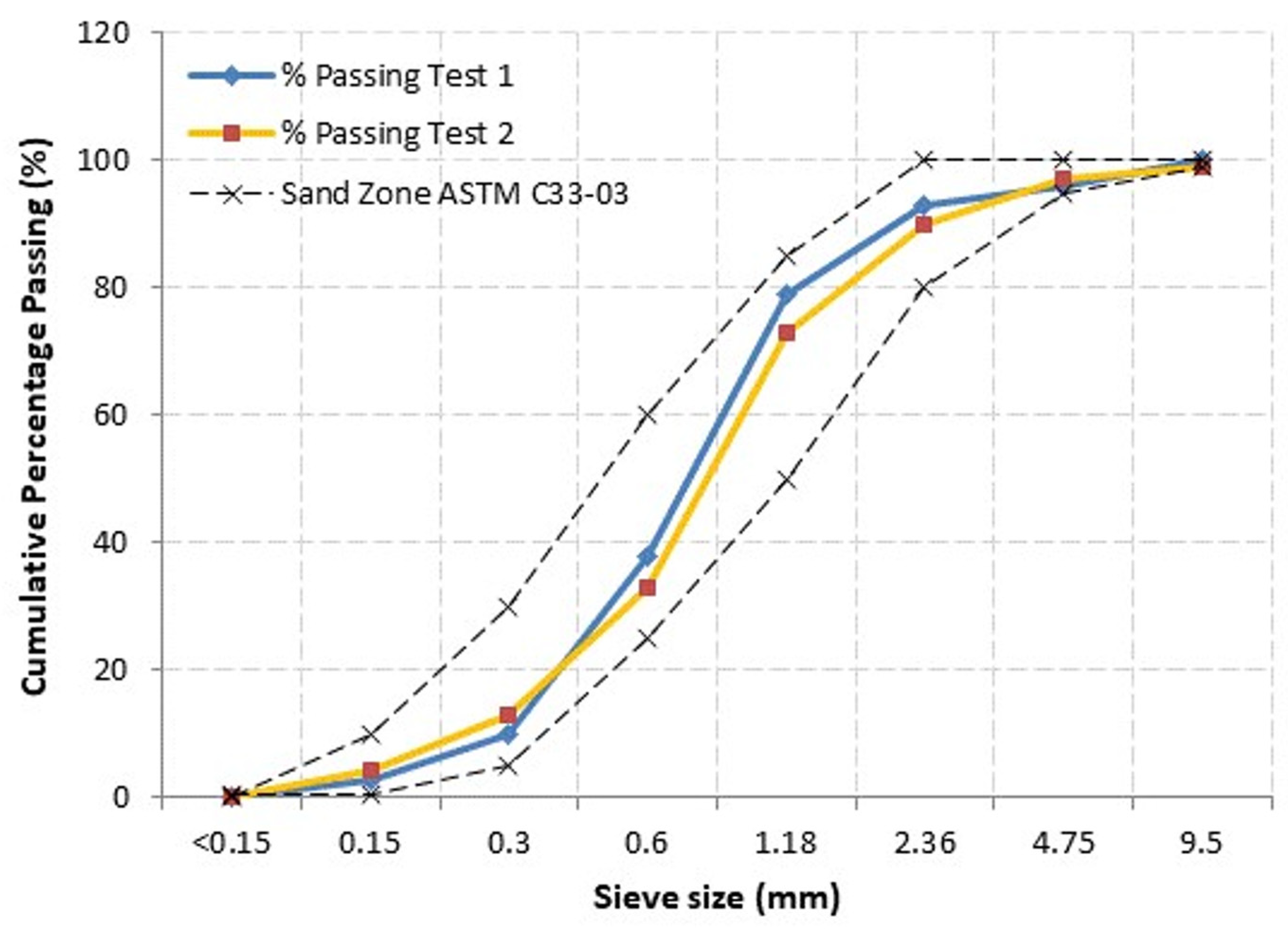

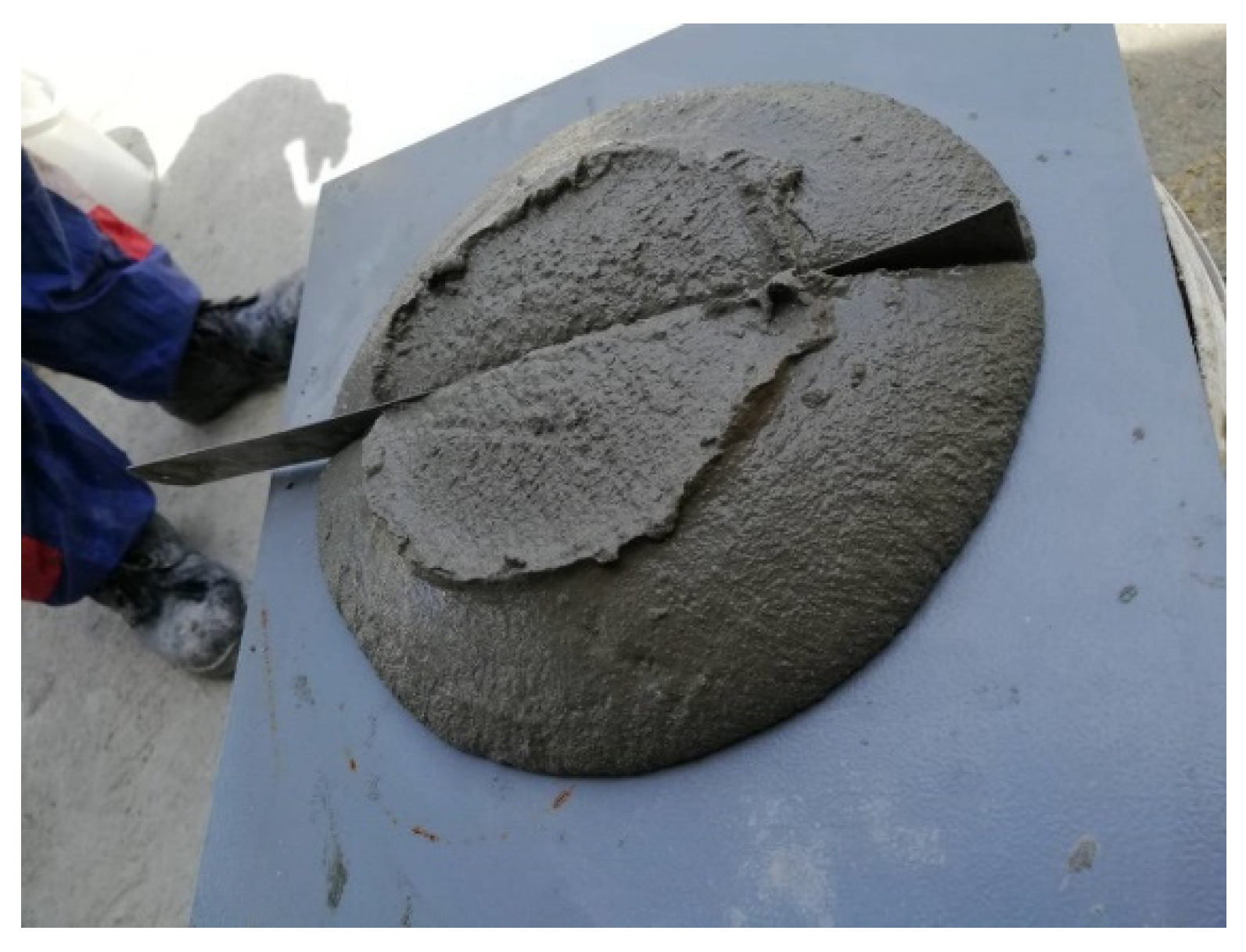
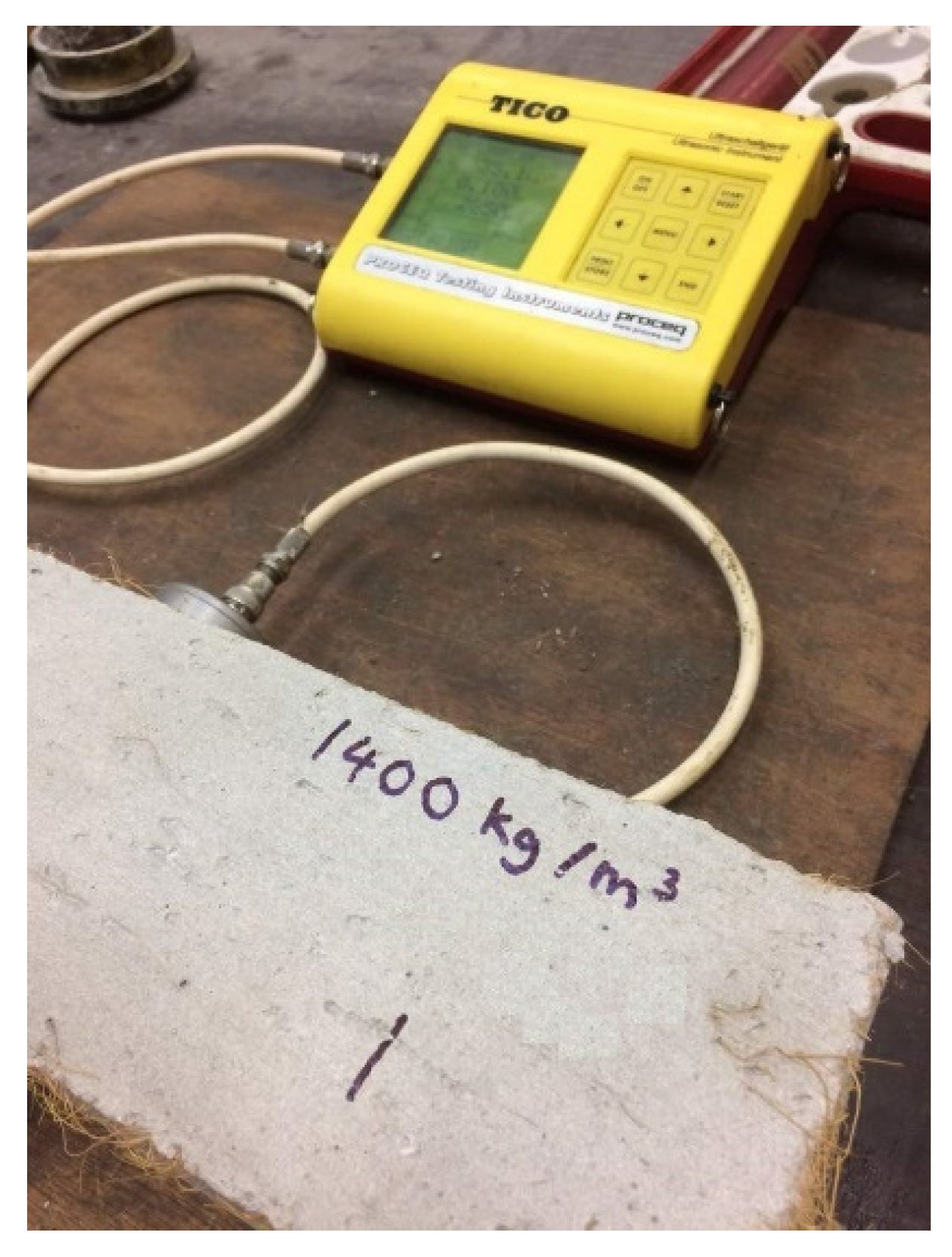
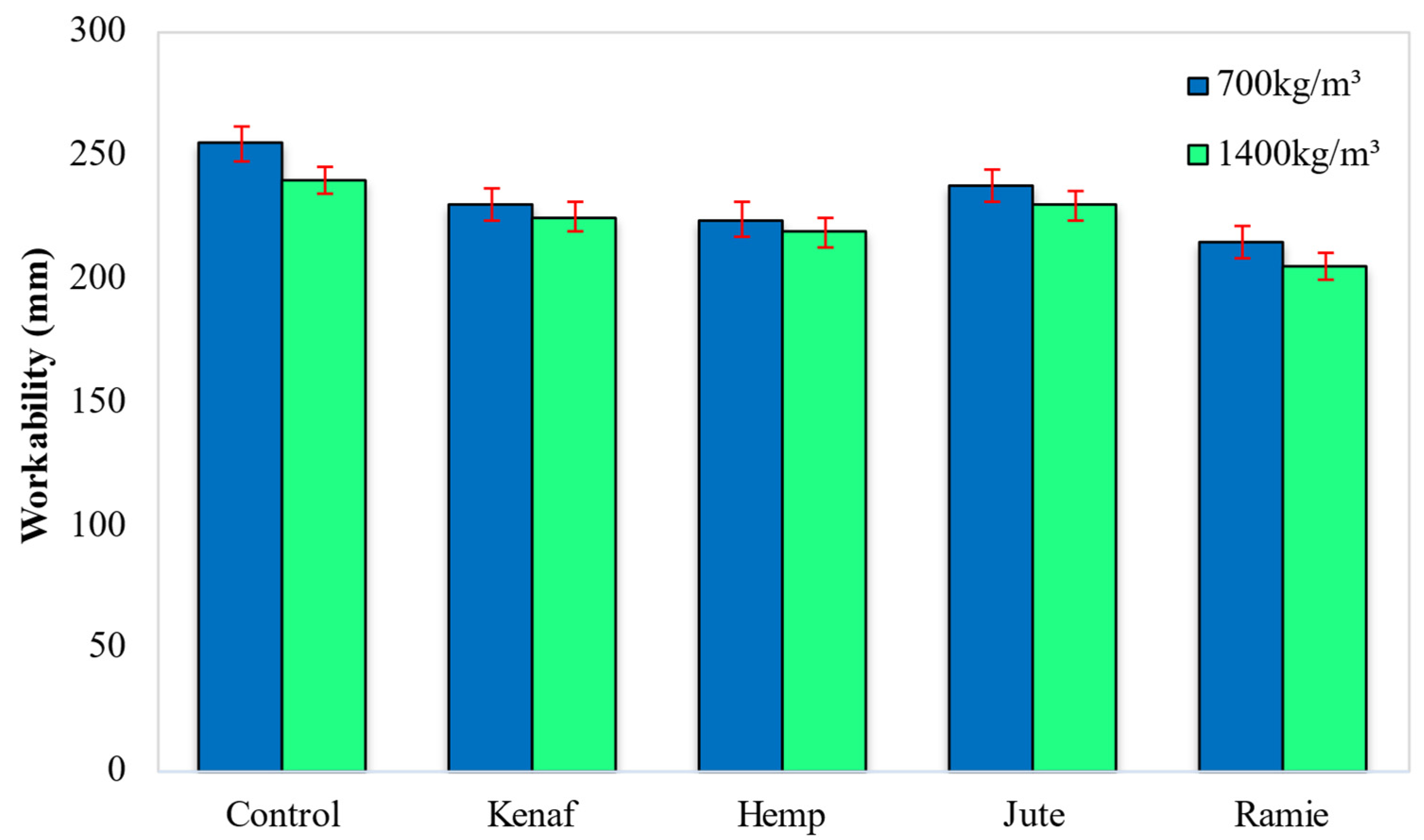
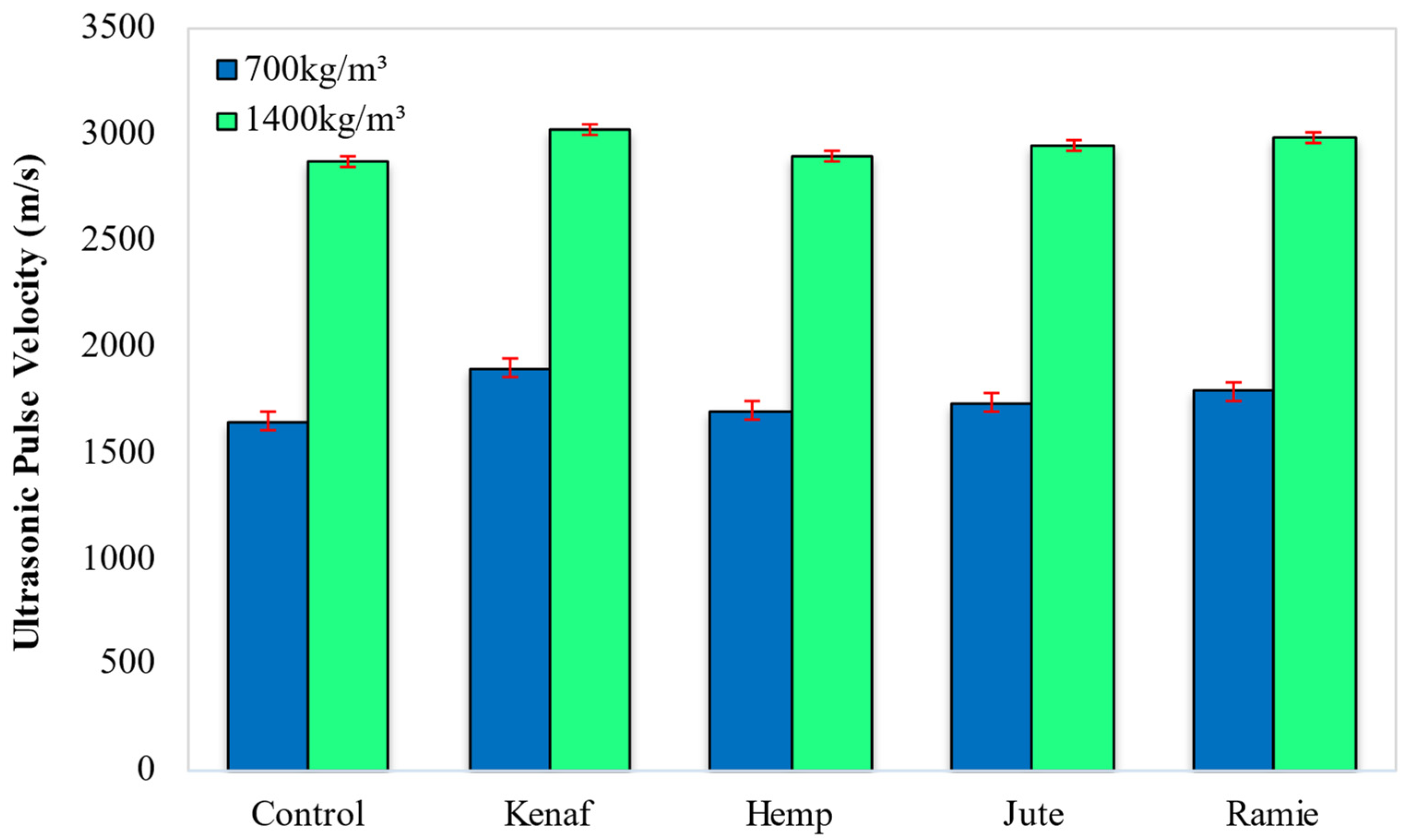

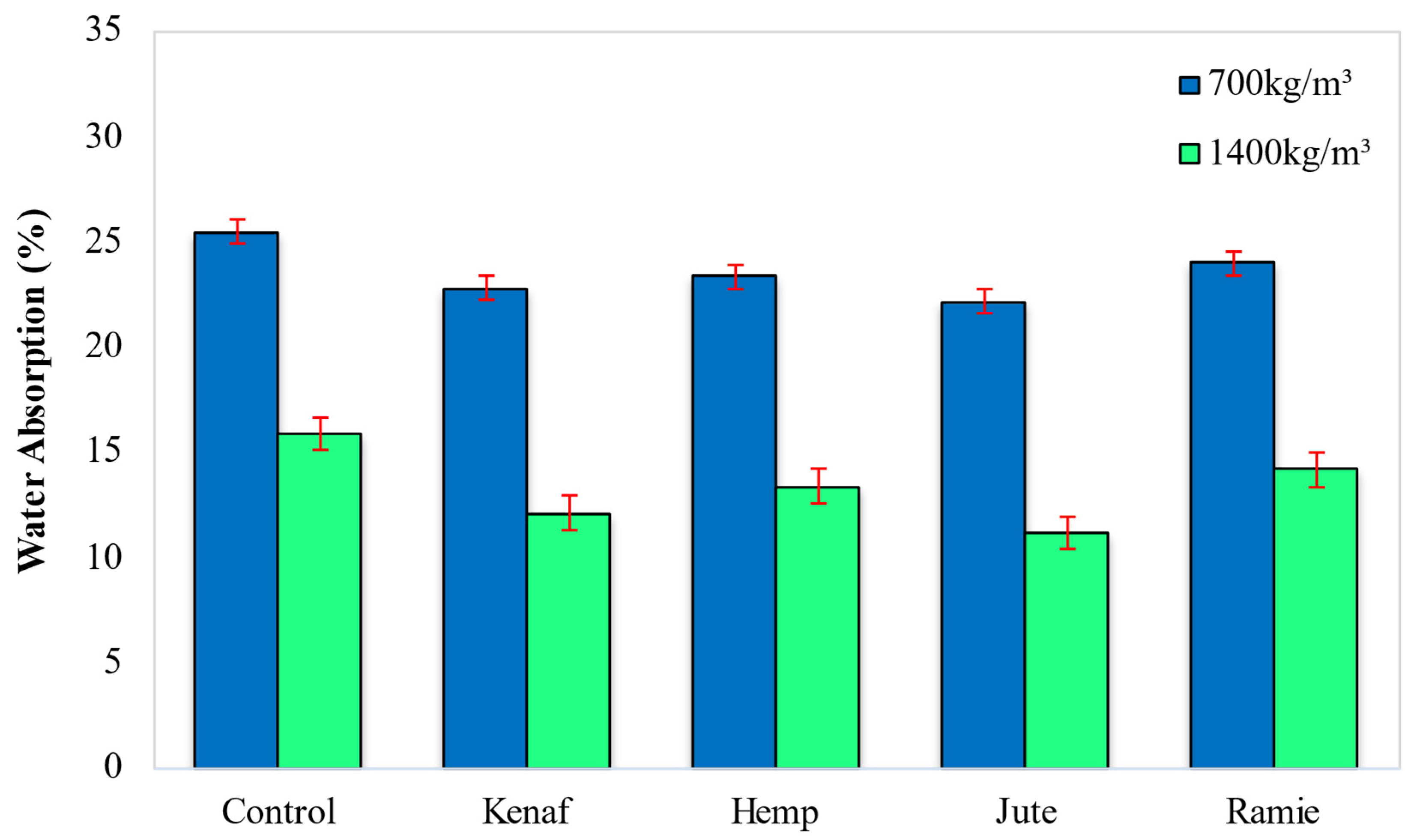
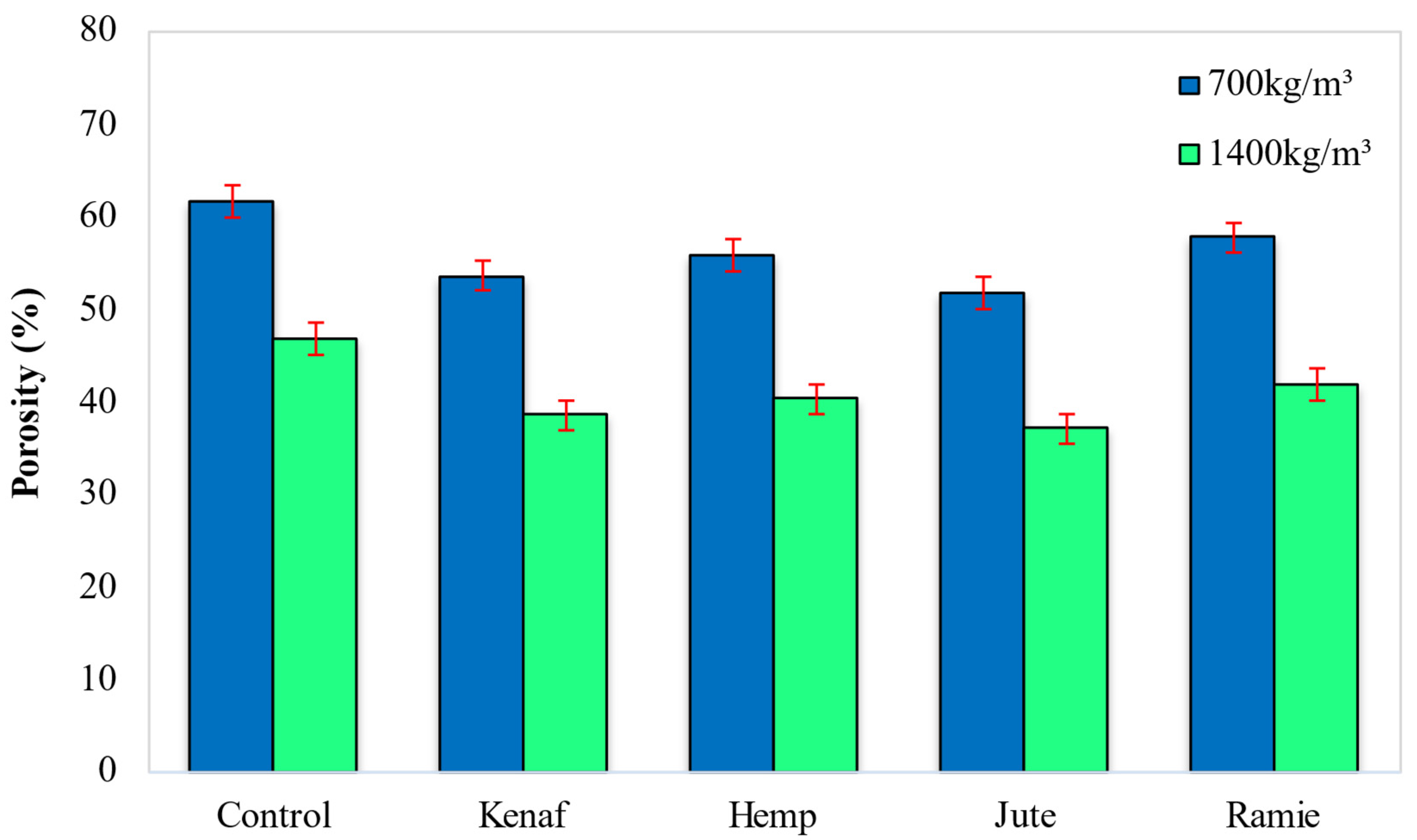
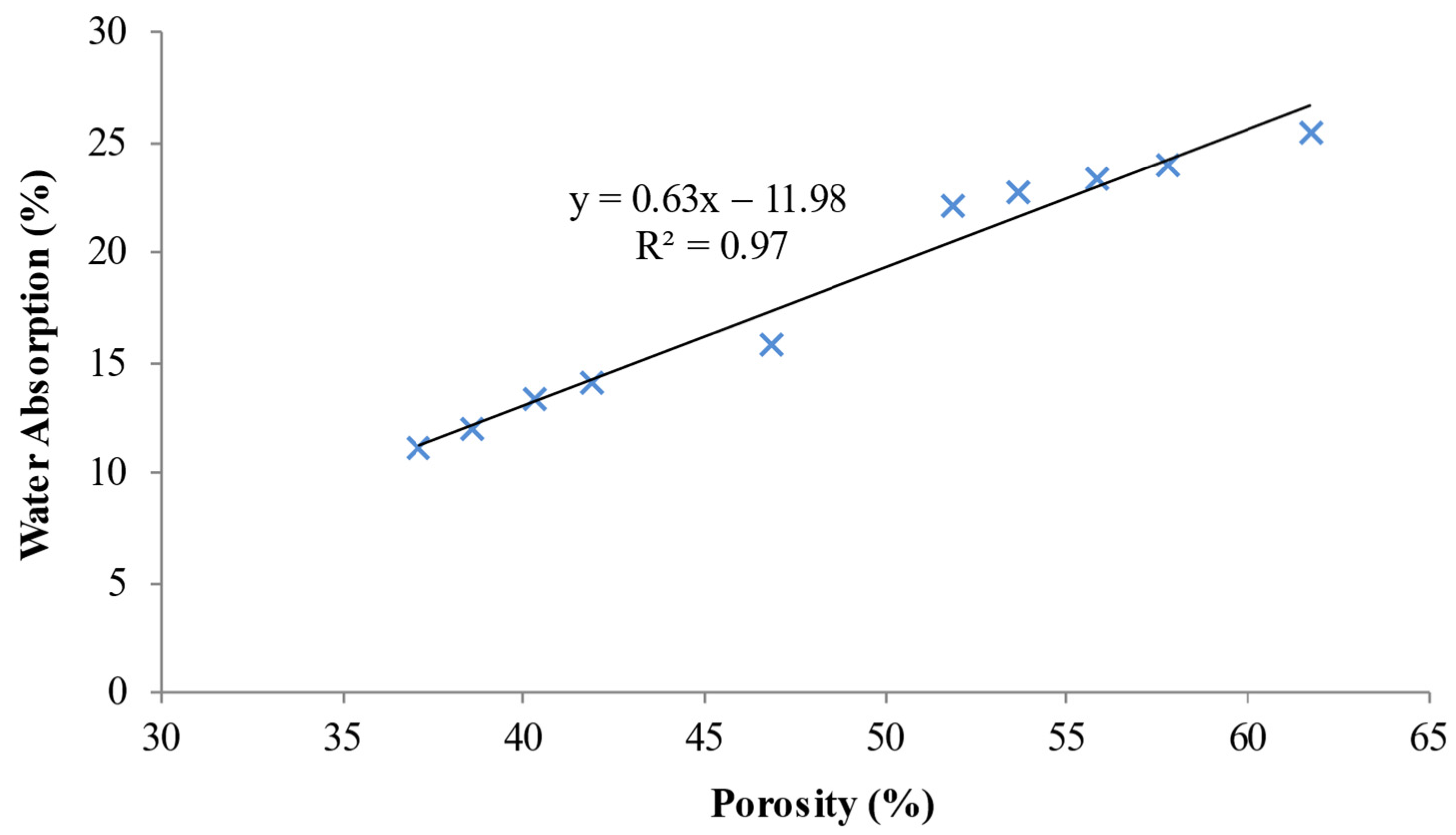
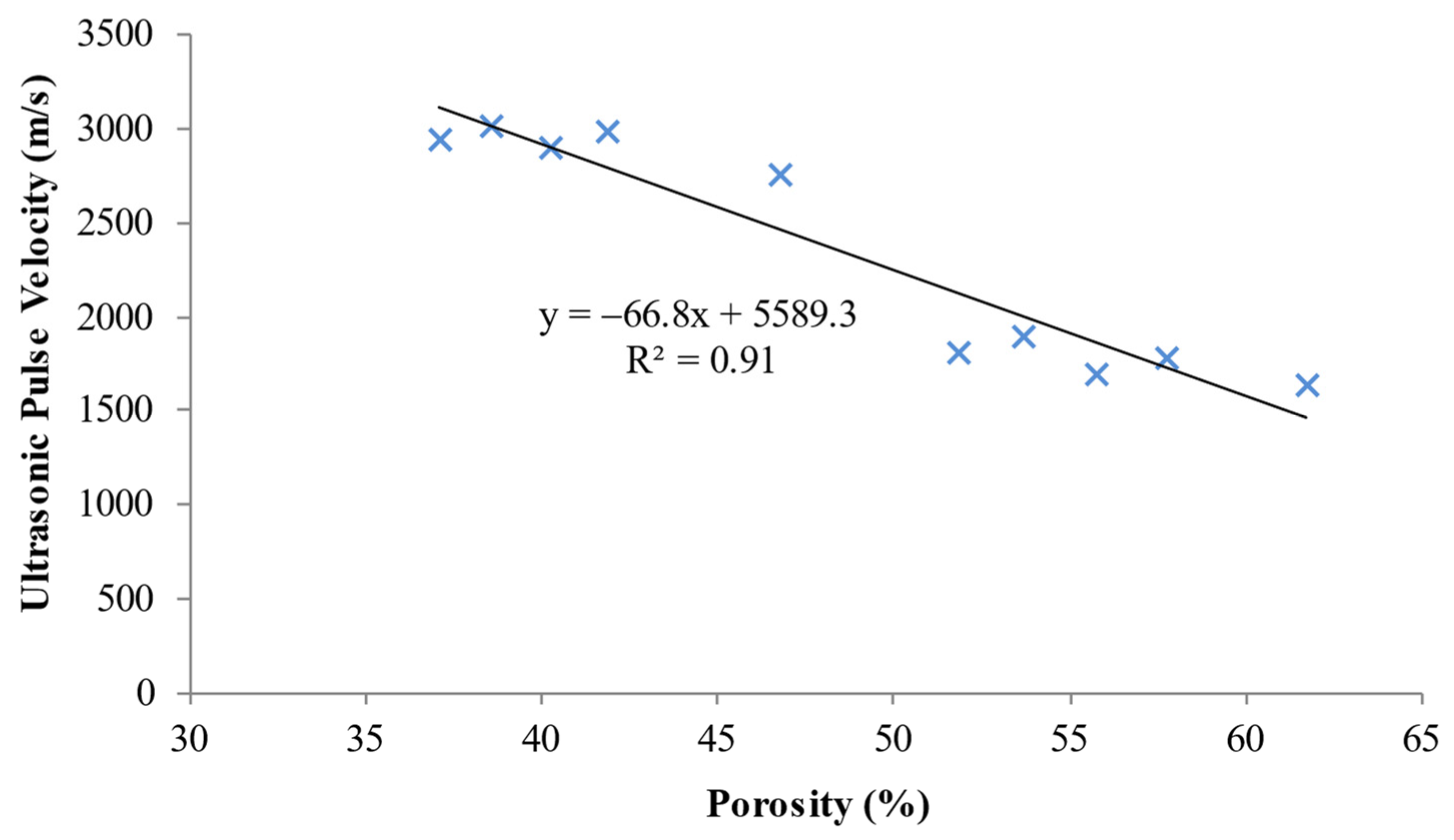
| Materials | Density (kg/m3) | Specific Surface Area (m2/kg) | Specific Gravity |
|---|---|---|---|
| OPC | 3.15 | 300 | 3.16 |
| Fine Sand | 2.11 | 450 | 2.61 |
| Oxide Components | Percentage (%) |
|---|---|
| Silicon | 20.18 |
| Aluminium | 4.65 |
| Ferrous | 3.59 |
| Calcium | 62.59 |
| Magnesium | 1.56 |
| Sulphur | 2.67 |
| Sodium | 0.23 |
| Potassium | 0.74 |
| Chloride | 0.03 |
| Free calcium | 1.21 |
| Loss of ignition | 1.23 |
| Insoluble residue | 1.32 |
| Composition | Kenaf | Hemp | Jute | Ramie |
|---|---|---|---|---|
| Cellulose (%) | 63.5 | 65.1 | 47.8 | 70.1 |
| Hemicellulose (%) | 14.2 | 8.2 | 23.5 | 10.2 |
| Lignin (%) | 11.3 | 14.7 | 17.8 | 9.3 |
| Ash (%) | 4.7 | 2.6 | 0.0 | 2.1 |
| Pectin (%) | 0.0 | 0.8 | 0.3 | 1.1 |
| Wax (%) | 0.1 | 0.6 | 0.5 | 0.3 |
| Moisture (%) | 6.2 | 8.0 | 10.1 | 6.9 |
| Physical Properties | Kenaf | Hemp | Jute | Ramie |
|---|---|---|---|---|
| Diameter (µm) | 198 | 75 | 121 | 155 |
| Fiber length (mm) | 25 | 25 | 25 | 25 |
| Density (kg/m3) | 1550 | 920 | 1380 | 1470 |
| Micro-fibrillar angle (°) | 7.0 | 3.5 | 8.0 | 7.5 |
| Mechanical Properties | Kenaf | Hemp | Jute | Ramie |
|---|---|---|---|---|
| Tensile strength (MPa) | 297.8 | 192.4 | 121.8 | 321.5 |
| Young’s modulus (GPa) | 19.8 | 14.5 | 12.23 | 16.7 |
| Torsional Rigidity (10−9 N/m2) | 1.56 | 1.19 | 0.82 | 1.35 |
| Elongation at break (%) | 6.56 | 9.96 | 11.45 | 8.95 |
| Poisson’s ratio (v) | 0.40 | 0.38 | 0.35 | 0.45 |
| Dry Density (kg/m3) | Fiber Types | Mix Ratio (C:S:W) | Fiber (kg) | Cement (kg) | Fine Sand (kg) | Water (kg) |
|---|---|---|---|---|---|---|
| 700 | - | 1:1.5:0.45 | 0.00 | 26.63 | 39.95 | 11.99 |
| 700 | Jute | 1:1.5:0.45 | 0.37 | 26.63 | 39.95 | 11.99 |
| 700 | Kenaf | 1:1.5:0.45 | 0.37 | 26.63 | 39.95 | 11.99 |
| 700 | Hemp | 1:1.5:0.45 | 0.37 | 26.63 | 39.95 | 11.99 |
| 700 | Ramie | 1:1.5:0.45 | 0.37 | 26.63 | 39.95 | 11.99 |
| 1400 | - | 1:1.5:0.45 | 0.00 | 51.91 | 77.87 | 23.36 |
| 1400 | Jute | 1:1.5:0.45 | 0.68 | 51.91 | 77.87 | 23.36 |
| 1400 | Kenaf | 1:1.5:0.45 | 0.68 | 51.91 | 77.87 | 23.36 |
| 1400 | Hemp | 1:1.5:0.45 | 0.68 | 51.91 | 77.87 | 23.36 |
| 1400 | Ramie | 1:1.5:0.45 | 0.68 | 51.91 | 77.87 | 23.36 |
Publisher’s Note: MDPI stays neutral with regard to jurisdictional claims in published maps and institutional affiliations. |
© 2022 by the authors. Licensee MDPI, Basel, Switzerland. This article is an open access article distributed under the terms and conditions of the Creative Commons Attribution (CC BY) license (https://creativecommons.org/licenses/by/4.0/).
Share and Cite
Othuman Mydin, M.A.; Mohd Nawi, M.N.; Odeh, R.A.; Salameh, A.A. Durability Properties of Lightweight Foamed Concrete Reinforced with Lignocellulosic Fibers. Materials 2022, 15, 4259. https://doi.org/10.3390/ma15124259
Othuman Mydin MA, Mohd Nawi MN, Odeh RA, Salameh AA. Durability Properties of Lightweight Foamed Concrete Reinforced with Lignocellulosic Fibers. Materials. 2022; 15(12):4259. https://doi.org/10.3390/ma15124259
Chicago/Turabian StyleOthuman Mydin, Md Azree, Mohd Nasrun Mohd Nawi, Ruba A. Odeh, and Anas A. Salameh. 2022. "Durability Properties of Lightweight Foamed Concrete Reinforced with Lignocellulosic Fibers" Materials 15, no. 12: 4259. https://doi.org/10.3390/ma15124259
APA StyleOthuman Mydin, M. A., Mohd Nawi, M. N., Odeh, R. A., & Salameh, A. A. (2022). Durability Properties of Lightweight Foamed Concrete Reinforced with Lignocellulosic Fibers. Materials, 15(12), 4259. https://doi.org/10.3390/ma15124259






